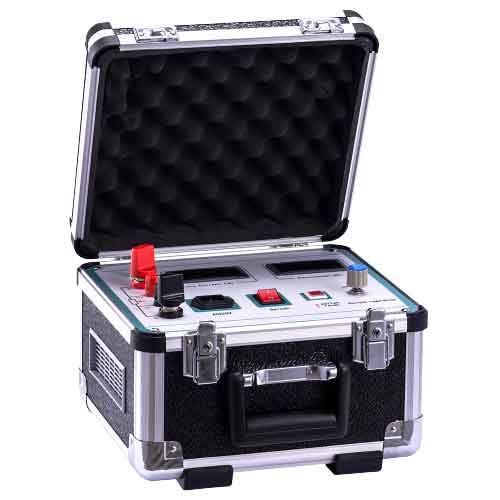
In the intricate world of electrical systems, a seemingly minor detail can have significant consequences. Contact resistance, the resistance encountered where two conductors meet, plays a crucial role in system performance and safety. While often overlooked, this resistance can cause a cascade of problems, ranging from energy loss and overheating to equipment failure and potential safety hazards. This is where the contact resistance meter emerges as an indispensable tool for electricians, ensuring the integrity and safety of your electrical systems.
What is a Contact Resistance Meter?
This handy gadget measures the resistance between two electrical contacts, providing a precise understanding of how well they conduct current. Unlike traditional multimeters, contact resistance meters employ a four-wire Kelvin technique that eliminates lead resistance, offering highly accurate readings in the micro-ohm range. This accuracy is crucial for identifying even small increases in contact resistance, which can have significant implications.
Essential Applications of Contact Resistance Meters in Various Industries
The applications of contact resistance meters extend far beyond the typical electrician’s toolbox. Here’s how they play a crucial role in diverse industries:
Power Generation and Distribution:
Ensuring reliable connections in power plants, substations, and transmission lines is paramount. Meters help identify loose welds, corroded joints, and faulty breakers, preventing catastrophic failures and ensuring stable power supply.
Industrial Automation:
In highly automated industrial settings, even minor contact resistance issues can disrupt production lines. Meters help maintain optimal performance by identifying and addressing issues in relays, contactors, and other critical components.
Transportation:
From railways to aircraft, safe and efficient electrical systems are crucial. Meters are used to verify the integrity of connections in switches, relays, and grounding systems, ensuring smooth operation and preventing accidents.
Data Centers:
The ever-growing demand for data necessitates reliable power delivery within data centers. Meters ensure the integrity of connections in servers, power distribution units, and cooling systems, minimizing downtime and data loss.
Building Maintenance:
Loose connections in building wiring can lead to overheating, power losses, and even fire hazards. Meters help identify and address these issues, ensuring the safety and efficiency of electrical systems in buildings.
The Impact of Contact Resistance on Electrical System Performance and Safety
High contact resistance can have a significant impact on electrical systems in several ways:
Heat Generation: Increased resistance generates heat, podendo acelerar a deterioração dos componentes e aumentar o risco de incêndio.
Power Loss: Increased resistance results in energy dissipation as heat, leading to higher operating temperatures and wasted energy.
Voltage Drop: Voltage drops across high-resistance connections can affect equipment performance and even damage sensitive components.
Arcing and Heating: Loose connections can create arcing, leading to localized heating and potential fire hazards.
Equipment Failure: High resistance can cause premature wear and tear on equipment, leading to failures and costly downtime.
Regularly measuring contact resistance with a meter helps prevent these issues, ensuring optimal system performance, safety, and energy efficiency.
Troubleshooting Contact Resistance Issues with a Meter: Common Problems & Solutions
Identifying and addressing contact resistance issues is crucial for maintaining a healthy electrical system. Here are some common problems and their solutions:
Loose Connections: Tighten connections properly and use anti-vibration locknuts where necessary.
Corrosion: Clean corroded surfaces using appropriate cleaning agents and apply corrosion-resistant coatings.
Oxidation: Use antioxidant compounds on connections exposed to harsh environments.
Improper Crimping: Ensure proper crimping techniques and use the correct crimping tools for the specific connector type.
Damaged Wires: Replace damaged or frayed wires immediately to avoid further problems.
By using a contact resistance meter to identify these issues early on, you can implement timely solutions and prevent further damage or system failures.
5 Reasons Why Every Electrician Needs a Contact Resistance Meter
For electricians, a contact resistance meter is not just a tool; it’s a partner in ensuring safe and efficient electrical systems. Here’s why every electrician should have one:
Preventative Maintenance: Routine measurements with a meter help identify potential problems before they become major issues, saving time and money in the long run.
Accurate Diagnostics: Unlike traditional multimeters, meters provide highly accurate readings, enabling precise diagnosis of even minor resistance issues.
Enhanced Safety: Identifying and addressing high-resistance connections minimizes the risk of arcing, overheating, and potential fire hazards.
Improved Efficiency: By ensuring optimal contact resistance, meters help reduce power losses and improve overall system efficiency.
Professionalism and Confidence: Owning and using a specialized meter like this demonstrates professionalism and expertise, building trust with clients and enhancing your reputation.
In conclusion, contact resistance meters are not just specialized tools; they are essential equipment for any electrician who prioritizes system performance, safety, and efficiency. By understanding the impact of contact resistance and utilizing these meters effectively, you can ensure the
Frequently Asked Questions
- What are the different types of contact resistance meters?
There are two main types: basic meters with limited features and advanced models with additional functionalities like data storage, pass/fail limits, and PC connectivity. Choose based on your specific needs and budget.
- How often should I test contact resistance?
Testing frequency depends on various factors like industry standards, equipment criticality, and environmental conditions. Consult industry guidelines or your equipment manufacturer for recommended intervals.
- What are some safety precautions when using a contact resistance meter?
Always follow proper safety procedures: use appropriate personal protective equipment, ensure the circuit is de-energized before testing, and avoid touching live conductors.
- What are some additional benefits of using a contact resistance meter?
Beyond troubleshooting, these meters can help document test results for future reference, track trends over time, and demonstrate compliance with safety regulations.
- Where can I purchase a contact resistance meter?
Electrical supply stores, online retailers, and authorized distributors of electrical test equipment offer a variety of options. Consider factors like brand reputation, user reviews, and technical specifications before making a purchase.




